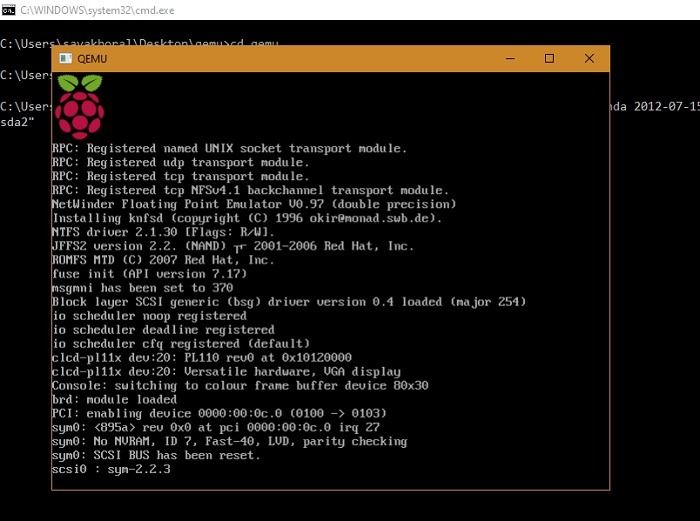

- RASPBERRY PI MAC EMULATOR HOW TO
- RASPBERRY PI MAC EMULATOR INSTALL
- RASPBERRY PI MAC EMULATOR FULL
- RASPBERRY PI MAC EMULATOR PASSWORD
- RASPBERRY PI MAC EMULATOR WINDOWS
RASPBERRY PI MAC EMULATOR HOW TO
I don’t know how to get the emulation on the internet. DONE! Should fire up! (I hope.) It worked for me, and I tried to remember all the steps that actually worked, which is hard because I had to flash my micro sd card about 6 times… Navigate to the image of your “Macintosh” emulator and you should see a “start” option. Ok now that the files are in the “macintosh” folder type the command:Īfter your pi has booted up you should see the RetroPie program: Emulation Station. Tell them you need it to draw a font or something, they can’t resist new fonts. Like using thumb drives and terminal commands, or probably downloading the files straight from the internet to the roms/macintosh folder… but I don’t know any commands other than reboot, cd, and ls, so your best bet is to use a mac, if you cant figure out the processes yourself and you don’t own a mac, find some young hip looking graphics designer and explain to them you need to borrow their computer.
RASPBERRY PI MAC EMULATOR PASSWORD
(user name pi password raspberry) then I was able to navigate to the said folders like a simple mortal would. Hit the “connect as…” button in the top corner. There are probably a billion different ways to do this but I did it by opening my file browser window on my mac and under the “shared” column I Selected the raspberry pi. Stick those two files into the “macintosh” folder. Find this file path on your the cd command, ie: cd RetroPie/roms/macintosh) Got it? You now have two files named disk.img and mac.rom. (maybe other roms work too, but if it wasn’t the Performa ROM, I couldn’t get it to work.)

If you end up with anything else you got hoodwinked by some webpage last updated in 1995. There were found quickly and both were towards the top of the search. I typed the file names into the search bar one at a time. If you were born in a country that has telephones then you have heard of this search engine and their many side projects. I used a powerful search engine whose colorful name rhymes with “mew gull”. You will need to search out these two files on your own. Because of litigation trolls, and the fact that all of these old decrepit websites keep changing hands from time to time, I will not post hotlinks. You need a file called “MacStartup.img” and a file called “Performa.rom”. Apparently some web sights convert two dash symbols into one long dash symbol to make your life suck)ĭespite what you might have read from other less… “helpful” instructions, Basilisk II is not ready to run yet. (make sure the following words start with two dashes: enable, enable, disable, disable. configure –enable-sdl-video –enable-sdl-audio –disable-vosf –disable-jit-compiler (I know you could just type the whole thing in, but I was worried updates would change the structure of the files so I wanted to show people what they were looking for and how to do it.) Now you should have the following command line in front of $

(including a gray basilisk.sh file, ignore this, it’s the computational equivalent of a harpy I think. Hit F4 to leave RetroPie and find yourself staring into the bottomless blackness that is Linux.Īnd a bunch of preinstalled emulators will show up. Everything you need to actually type will be in bold. After you type in the command, hit return/enter.ĥ.
RASPBERRY PI MAC EMULATOR FULL
And as far as I’m concerned whoever invented the command line can go shove a full sized computer keyboard up their. I am using a RaspberryPi (B+) model with RetroPie 3.4.something or other OS.ģ.
RASPBERRY PI MAC EMULATOR WINDOWS
I use macintosh computers so if you’re on a windows machine you’ll have to figure some stuff out own your own. Here is as detailed a guild as I could muster:īefore I being you should know these things:ġ.

RASPBERRY PI MAC EMULATOR INSTALL
So after reading approximately half of the internet and every Linux forum page published since 1992 I have discovered in just 3 short days (actually it was 56 hours not including bathroom breaks) how to successfully install Basilisk II on your raspberry pi. To make matters worse it turns out the approximately 114 online guides all have several inaccuracies, bad links, evil spirits, or ambiguous commands. So the problem is you don’t know anything about linux, or command lines, and you don’t have time to read 600 volumes explaining Bash. A Detailed guild to installing Basilisk II (BasiliskII), and actually getting it to work, on your Raspberry Pi.


 0 kommentar(er)
0 kommentar(er)
